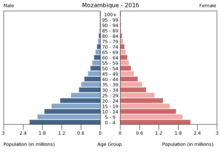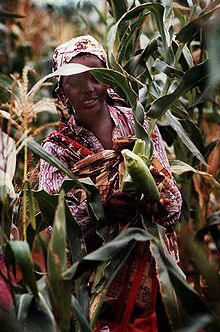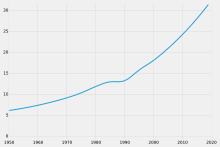Mozambique
![]()
This article is about the state in southern Africa. For other meanings, see Mozambique (disambiguation).
Template:Infobox State/Maintenance/NAME-German
Mozambique [mozamˈbiːk, mozamˈbɪk] (Portuguese Moçambique [mʊsɐ̃ˈbik]) is a country in Southeast Africa.
Mozambique is located on the Indian Ocean between the 10th and 27th southern latitudes. The state borders Tanzania, Malawi, Zambia, Zimbabwe, South Africa and Eswatini. The Strait of Mozambique separates the island nation of Madagascar from the African mainland. The capital is Maputo, other important cities in Mozambique are Matola, Beira and Nampula.
Mozambique gained independence from Portugal on 25 June 1975. Due to a civil war that followed for years, it is still one of the poorest countries in the world. Mozambique has been a member of the Commonwealth of Nations since 12 November 1995. Since the discovery of large oil fields off the coast of Cabo Delgado province in the north in 2010/2011, the country has great potential for economic recovery. However, recent years have also seen an increase in divisions between the country's many cultures and religions. At the latest since the spread of the Islamist terrorist organization IS since 2015 (also in the province of Cabo Delgado), the state of Mozambique threatens to fail.
Geography
Location and description
Along the 2800 km coastline is a broad coastal lowland. It covers most of the south, but narrows from the mouth of the Zambezi River to the north. Behind the coast the land rises in steps to the table land of the high field, about 1000 m high. The highest mountain is the Monte Binga in the province Manica (at the border to Zimbabwe) with 2436 m.
With a land area of 801,590 km², Mozambique ranks 34th in the world. 18 % of the country's area is forest and bush land, 4 % arable land, 55 % meadows and pastures.
The extension of the country in the north-south direction is 2000 km, in the west-east direction 50 to 600 km. The coast on the Indian Ocean is 2800 km long.
Mozambique has 4571 km of land borders, including 756 km with Tanzania, 1569 km with Malawi, 419 km with Zambia, 1231 km with Zimbabwe, 491 km with South Africa and 105 km with Eswatini.
Climate
Savannah climate with a wet and a dry season prevails. In the rainy season, which lasts from November to April, about 80% of the annual precipitation falls. Depending on the region, this varies between 700 and 1500 mm per year. While the temperatures during the rainy season are hot and humid (tropical), the dry season is characterized by much cooler nights. The whole year the day temperatures are between 25 and 30 °C, in the inland also up to 35 °C. The nights are sometimes very humid at around 15 to 25 °C, especially on the coast.
In some years, such as 2007/2008, there was unusually high rainfall, which claimed lives and threatened crops. Overall, the country experiences high climate variability and frequent extreme weather events (especially droughts, floods, tropical cyclones). Droughts are the most common disasters, occurring about every three to four years and massively hampering the country's development. In terms of the consequences of global warming, it is believed that while cyclones may become less frequent, their intensity, and therefore rainfall, is likely to increase. In 2019, for example, Cyclones Idai and Kenneth were unusually intense and caused severe damage. These weather events may also lead to increased erosion in coastal areas. Since much of the population, and especially many poor people in rural areas, depend on rain-fed agriculture for their livelihoods, they are particularly vulnerable to changes in rainfall patterns.
Waters
The country's numerous rivers flow eastward from the highlands into the Strait of Mozambique. The largest river is the Zambezi (2,574 km), which is dammed in western Mozambique by the Cahora Bassa Dam. Other major rivers include the Rovuma, the border river with Tanzania, and Save and the Limpopo. Lake Malawi forms part of the border with Malawi; its outlet is the Shire, which flows into the Zambezi. Together with the Lurio, the catchments of these rivers account for over half of the country. However, due to its geography, Mozambique has only a comparatively small share in the catchment areas of the International Rivers.
See also: List of rivers in Mozambique
Flora
The predominant vegetation is dry savannah with dry grasslands and some dry forests. The trees in the savannah partially shed their leaves in the dry season and turn green in the course of the rainy season. Typical trees of the dry savannah are umbrella acacias and baobabs. The grass is brown and withered in the dry season, but grows up to 2 meters high during the rainy season.
Population
Demographics
The average life expectancy at birth in 2019 was 60.9 years. 44.4% of the population was under 15 years of age in 2019 and just under 3% was over 65. The total fertility rate was 4.8 children per woman. The rate was still around 6.5 children per woman around 1970 and has been steadily declining since then. This is partly due to the fact that modern contraceptive methods are available to more and more married women. From 2008 to 2019, the rate increased from 12% to 50%. The country has one of the highest HIV prevalence rates in the world (12.3%), which is holding back population growth. This was 2.9% in 2019.
According to the UN medium population projection, the population is expected to exceed 65 million by 2050.
| Development | |
| Year | Population |
| 1950 | 06.152.000 |
| 1960 | 07.389.000 |
| 1970 | 09.162.000 |
| 1980 | 11.848.000 |
| 1990 | 13.248.000 |
| 2000 | 18.068.000 |
| 2010 | 24.221.000 |
| 2020 | 31.255.000 |
| 2030 | 41.185.000 |
Ethnic groups
The majority of the total population belongs to the Bantu people. The Makua are the largest people with about 40% of the population, and the Tsonga are also an influential group with 21%. The Yao, who also live in Malawi, make up 12 % of the population, and the Makonde in the northeast are also a strong minority with 11 %. The East African Swahili ethnic group lives in the coastal area and makes up 7% of the population. In addition, the Chewa still live in the country with a share of 4 % of the population - their main settlement area is Malawi. The smaller minority of the 3% Shona in the west forms the majority of the population in Zimbabwe.
In 2017, 0.8% of the population was foreign-born. Furthermore, Mozambique is home to many people with a migrant background (Indians, Pakistanis, Chinese), Europeans (mainly Portuguese) and South Africans. The return of almost five million internally displaced persons (IDPs) to their places of origin and the return of 1.7 million refugees from neighbouring countries after the end of the Mozambican civil war, as well as around 15,000 Mozambicans from the former German Democratic Republic, so-called Madgermanes, pose major challenges for the country.
Mozambique has a significant diaspora in South Africa. In 2017, approximately 680,000 Mozambican-born people lived there. Other countries with many Mozambicans abroad are Zimbabwe (90,000) and Portugal (70,000).
See also: History of the Indians in Mozambique
See also: Ethnic groups in Mozambique
Languages
| Knowledge of Portuguese (2007) | ||
| Available | 50,37 % | |
| not available | 48,72 % | |
| k. A. | 00,90 % | |
| Most spoken language at home (2007 as well as 1998) | ||||
| Portuguese | 2.088.798 | 12,78 % | 489.915 | 3,0 % |
| Makua | 4.153.811 | 25,42 % | 4.007.010 | 24,8 % |
| Changana | 1.710.801 | 10,47 % | 1.799.614 | 11,2 % |
| Chilomwe | 1.132.755 | 6,93 % | 1.269.527 | 7,9 % |
| Sena | 1.171.673 | 7,17 % | 1.807.319 | 11,2 % |
| Chuwabo | 733.926 | 4,49 % | ||
| Other Mozambican language | 4.718.907 | 28,87 % |
| |
| Other foreign language | 30.969 | 0,19 % |
| |
| K. A. | 5.118 | 0,03 % | ||
| Unknown | 596.735 | 3,65 % | ||
| Total | 16.343.493 | 100,00 % | 16.135.403 | 100,00 % |
In total, over 40 languages are spoken in the country. The indigenous languages belong to the Bantu language group. According to the 2007 census, Portuguese, the only official language, is now spoken as a mother tongue by about 12 % of the total population (mainly in cities), but about 25 % in Maputo. A good 50% speak Portuguese as a second language alongside their native language. Most Mozambicans speak more than one indigenous language. In addition to the official language Portuguese, the most important languages include (sorted by share of speakers):
- Makua, also eMakhuwa - the most important language in northern Mozambique is spoken by 25.3% of the population according to the 2007 census. 40% of the inhabitants are considered ethnic Makua. These speak different variants within an eMakua dialect continuum or "Makhuwa languages" - nine in Mozambique according to Ethnologue - of which the "Central Makhuwa" - with 3.09 million speakers in 2006 - is also known simply as "eMakhuwa" or "eMakua".
- Changana - spoken by 10.7% of the population in the southwest in Maputo Province and Gaza Province, also called Ronga in Maputo City; however, the ethnic Tsonga population is 21%.
- Sena - in Sofala Province by 7.5% of the population
- Chilomwe - 7 % of the population (closely related to eMakhua)
- Chuwabo - 5.1% of the population
- Swahili - in the north (border to Tanzania)
- ChiMakonde - in the northeast (Cabo Delgado province)
- Chichewa - also called Nyanja; in the west (Tete province), the area borders Zambia and Malawi, where this language is also spoken.
- Shona - spoken by the Shona people
- Ndau - spoken in Sofala province, related to the Shona language
- Tswa - in the southeast (Inhambane province)
Among the foreign languages, those spoken by Chinese, Indian and Pakistani immigrants stand out.
Religion
During the colonial period, the Roman Catholic Church was by far the most important Christian denomination. Since independence, however, evangelical movements have gained increasing importance. The popular TV station TV Miramar, which is owned by the Brazilian faith healer sect Igreja Universal do Reino de Deus, which distributes Christian fundamentalist content in addition to well-known Brazilian telenovelas, is of particular importance.
According to a 2007 survey, a total of 28.4% of the population is still Roman Catholic (mainly in the south and southwest) and 17.9% Muslim (mainly Sunni, mainly in the north and coastal regions). 15.5% are Zionist Christians. Protestants make up 12.2% of the population, of which 10.9% are Pentecostal and 1.3% Anglican. 6.7% belong to other religions, mostly traditional religions. 18.7% do not belong to any religion and 0.7% are not recorded.

Mozambique population pyramid (2016)

Woman harvesting corn

Population development in millions of inhabitants
Questions and Answers
Q: What is the capital of Mozambique?
A: The capital of Mozambique is Maputo.
Q: When did Mozambique gain independence from Portugal?
A: Mozambique gained independence from Portugal on June 25th, 1975.
Q: What language is the official language of Mozambique?
A: Portuguese is the official language of Mozambique.
Q: How many people live in Mozambique?
A: Approximately 31 million people live in Mozambique.
Q: What are some natural resources found in Mozambique?
A: Some natural resources found in Mozambique include large natural gas reserves and minerals such as coal, titanium, gold, and bauxite.
Q: What are some important partners for the country?
A: Important partners for the country include Portugal, Spain, and Belgium.
Q: What religions are practiced in Mozambique?
A: Christianity is the largest religion practiced in Mozamibque; however there are also Muslim and African traditional religious minorities present.
Search within the encyclopedia